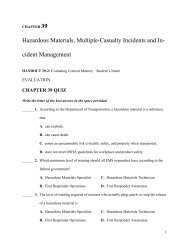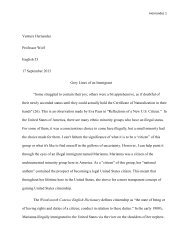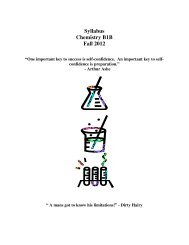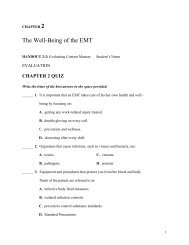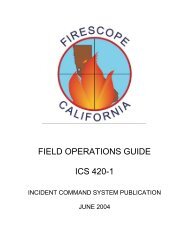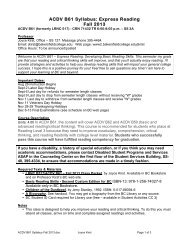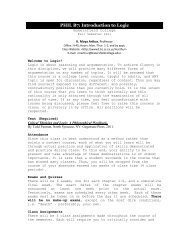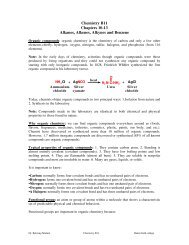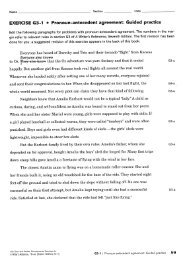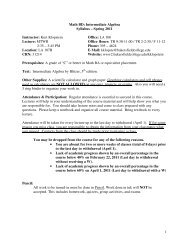Lecture notes Chapters 14-15 - Bakersfield College
Lecture notes Chapters 14-15 - Bakersfield College
Lecture notes Chapters 14-15 - Bakersfield College
You also want an ePaper? Increase the reach of your titles
YUMPU automatically turns print PDFs into web optimized ePapers that Google loves.
Chemistry B11Chapter <strong>14</strong>-<strong>15</strong>Alcohols, Ethers, Thiols and ChiralityAlcohols: the functional group of an alcohol is an hydroxyl group “-OH”.CH 3 OHCH 3 CH 2 CH 2 OHNaming alcohols: 1. Select the longest chain that contains the –OH group as the parentalkane. 2. Number chain from the end that gives –OH the lower number. 3. Change the endingof the parent alkane from “-e” to “-ol” and use a number to show the location of the –OHgroup. 4. Give the location and number of each substituent and list them in alphabetical orderas a prefix to the name of the main chain.CH 3CH 3 -CH 2 -CH-CH 2 -OH4 3 2 12-methyl-1-butanolCommon name: name the alkyl group bonded to –OH and then add the word “alcohol”.CH 3 OHCH 3 -CH 2 -OHIUPAC name: Methanol (Common name: Methyl alcohol)IUPAC name: Ethanol (Common name: Ethyl alcohol)Diol and Triol: a compound containing two hydroxyl groups is named as a diol. A compoundcontaining three hydroxyl groups is named as a triol, and so on.Naming Diols and Triols: the final –e in the name of the parent alkane is retained and weadd “-diol” or “-triol”.Note: as a common name, a compound containing two hydroxyl groups on adjacent carbonsis often referred to as “glycol”. We add the word “glycol” at the end of the name of thealkene.CH 2 -CH 2 CH 3 -CH-CH 2 CH 2 -CH-CH 2OH OHOH OH OH OH OH1,2-Ethanediol 1,2-Propanediol 1,2,3-Propanetriol(Ethylene glycol) (Propylene glycol) (Glycerol, Glycerin)Phenol: a compound that contains an hydroxyl group (-OH) bonded to a benzene ring.Phenols are weak acids, with pK a values of approximately 10. Most phenols are insoluble inwater, but they react with strong bases, such as NaOH and KOH, to form water-soluble salts.OH NaOH H 2O+O - Na ++H 2 OPhenolSodium phenoxide(a water-soluble salt)Dr. Behrang Madani Chemistry B11 <strong>Bakersfield</strong> college
Classification of alcohols: alcohols are classified as primary (1°), secondary (2°), or tertiary(3°), depending on number of carbon atoms bonded to the carbon bearing the –OH group.HCH 3 -C-OHHA 1° alcoholHCH 3 -C-OHCH 3A 2° alcoholCH 3CH 3 -C-OHCH 3A 3° alcoholPhysical properties of alcohols: 1. Because of the large difference in electronegativitybetween oxygen and carbon (3.5 - 2.5 = 1.0) and between oxygen and hydrogen (3.5 - 2.1 =1.4), alcohols are polar molecules. 2. There is hydrogen bonding between the alcoholmolecules (because of –OH). 3. Alcohols have higher boiling points than do alkans, alkenes,and alkynes of similar molecular weight (hydrogen bonding and dipole-dipole interactions arestronger than London dispersion forces). 4. The larger alcohol molecules (higher molecularweight) have higher boiling points. 5. Alcohols are much more soluble in water than arealkanes, alkenes, and alkynes (solubility decreases when molecular weight increases). Theyare weak acids (weaker than phenol).Chemical properties of alcohols:1. Acidity of alcohols: Phenols are weak acids and react with aqueous sodium hydroxide toform water-soluble salts. Alcohols are considerably weaker acids than phenols and do notreact in this matter.2. Acid-Catalyzed Dehydration alkenes: we can convert an alcohol to an alkene byeliminating a molecule of water from adjacent carbon atoms in a reaction called dehydration.The dehydration of an alcohol is most often brought about by heating it with either 85%phosphoric acid or concentrated sulphuric acid.CH 3 CH 2 OH H 2 SO 4180°CEthanolCH 2 =CH 2Ethylene+H 2 ONote: Primary alcohols-the most difficult to dehydrate- generally require heating inconcentrated sulphuric acid at temperature as high as 180ºC. Secondary alcohols undergodehydration at somewhat lower temperature. Tertiary alcohols undergo dehydration attemperature only slightly above room temperature.Note: Dehydration is reversible and by adding water to an alkene we can produce an alcohol(hydration).C CAn alk ene+ H 2 Odehy dratio nde h yd ratio nC CH OHAn alcoh olDr. Behrang Madani Chemistry B11 <strong>Bakersfield</strong> college
3. Oxidation of alcohols:3.1. Oxidation of primary alcohols (1°): in the oxidation of a primary alcohol (1°), one H isremoved from the –OH group and another H from the C bonded to the –OH (oxidation iseither the loss of hydrogens or the gain of oxygens). A primary alcohol can be oxidized firstto an aldehyde and then to a carboxylic acid. In this reaction, Potassium dichromate(K 2 Cr 2 O 7 ) will be used as the oxidizing agent and concentrated sulfuric acid solution is usedas a catalyst.OHCH 3 -C-HHEthanol(Ethyl alcohol)OCH 3 -C-H + H 2 OEthanal(Acetaldehyde)3.2. Oxidation of secondary alcohols: it is similar to the oxidation of primary alcohols.Secondary alcohols may be oxidized to ketones by using potassium dichromate as theoxidizing agent.OHCH 3 -C-CH 3H2-propanolOCH 3 -C-CH 3 + H 2 O2-propanoneNote: tertiary alcohols resist oxidation because the carbon bearing the -OH is bonded to threecarbon atoms and, therefore, cannot form a carbon-oxygen double bond.Note: in our body, enzymes in the liver oxidize ethanol and the aldehydes can be produced.The blood alcohol over 0.4% can be fatal.Ethers: the functional group of an ether is an atom of oxygen bonded to two carbon atoms(C-O-C).Naming of ethers: ethers are named by listing the alkyl groups bonded to oxygen inalphabetical order and adding the word “ether”.CH 3 -O-CH 3CH 3 -CH 2 -O-CH 2 -CH 3CH 3 -CH 2 -O-CH 3Dimethyl etherDiethyl etherEthyl methyl etherPhysical properties of ethers: 1. They are polar compounds (oxygen bears a partial negativecharge and each attached carbon bears a partial positive charge). 2. Only weak dipole-dipoleinteractions exist between ether molecules (between carbon atom of a molecule and oxygenatom from another molecule). 3. The boiling points of ethers are higher than hydrocarbons ofsimilar molecular weight (lower than alcohols). 4. They are more soluble in water thanhydrocarbons of similar molecule weight (because they are polar).Dr. Behrang Madani Chemistry B11 <strong>Bakersfield</strong> college
δ+δ+δ+Chemical properties of ethers: ethers resemble hydrocarbons in their resistance to chemicalreaction. They do not participate in oxidation and reduction reactions. Because of theirgeneral inertness to chemical reactions, ethers are excellent solvents in which to carry outmany organic reactions.Thiol: the functional group of a thiol is an –SH (sulfhydryl) group bonded to a tetrahedralcarbon atom.CH 3 -SH methanethiol CH 3 -CH 2 -SH EthanethiolNaming of thiols: we name them by selecting the longest carbon chain that contains the –SHgroup. We add the word “-thiol” as suffix to the name of the parent alkane. The parent chainis numbered in the direction that gives the –SH group the lower number.δ-CH 3CH 3 -CH-CH 2 -CH 2 -CH 2 -SH5 4 3 2 <strong>14</strong>-methyl-1-pentanethiolPhysical properties of thiols: 1. They have unpleasant odors. 2. They are nonpolarcompounds (because of the small difference in electronegativity between sulfur and hydrogen(2.5 – 2.1 = 0.4)). 3. They have low boiling points (London dispersion forces). 4. They arealmost insoluble in water (because they are nonpolar compounds).Chemical properties of thiols:1. They are weak acids and react with strong bases such as NaOH to form a salt (ther arecomparable in strength to phenols).CH 3 CH 2 SH + NaOHH 2 OCH 3 CH 2 S - Na + + H 2 O2. Oxidation of thiols: thiols are readily oxidized to disulfide (-S-S-) by molecular oxygen.They must be protected from contact with air during their storage. This reaction is reversibleand disulfides can be reduced by several reducing agents.2HOCH 3 CH 2 SH + O 2oxidationreductionHOCH 2 CH 2 S-SCH 2 CH 2 OHChiral: an object that is not superposable on its mirror image.Achiral: an object that lacks chirality; an object that is superposable on its mirror image.Dr. Behrang Madani Chemistry B11 <strong>Bakersfield</strong> college
Stereocenter: a tetrahedral carbon atom that has four different groups bonded to itEnantiomers: isomers that are nonsuperposable mirror images. The most common cause ofenantiomerism in organic molecules is the presence of a carbon with four different groupsbonded to it (stereocenter).IsomerssameconnectivityStereoisomersdifferentconnectivityConstitutional IsomerswithoutstereocenterswithstereocentersAchiralCis-Trans IsomersEnantiomersChiralDiastereomersNote: enantiomers have different physical and chemical properties.Example: 2-butanol is a chiral compound and it is not superposable on its mirror. If we holdthe mirror image by the C-OH bond and rotate the bottom part of molecule by 180° about thisbond, you can see the orientation of H and -CH 2 CH 3 is different between original moleculeand the mirror image rotated. You notice that we have two different compounds.OHCH 3 CHCH 2 CH 3Original molecule180° OHHCCH3CH 3 CH 2Mirror imagerotate by 180°about theC-OH bondH 3 COHCCH 2 CH 3HThe mirror imagerotated by 180°Example: 2-propanol is an achiral compound and it is superposable on its mirror. If we holdthe mirror image by the C-OH bond and rotate the bottom part of molecule by 120° about thisbond, you can see that the original molecule is similar to the mirror image rotated.Consequently, they are identical compounds.OHCH 3 CHCH 3Original molecule120°HH 3 COHCCH3Mirror imagerotate by 120°about theC-OH bondH 3 COHCHCH 3The mirror imagerotated by 120°Dr. Behrang Madani Chemistry B11 <strong>Bakersfield</strong> college



